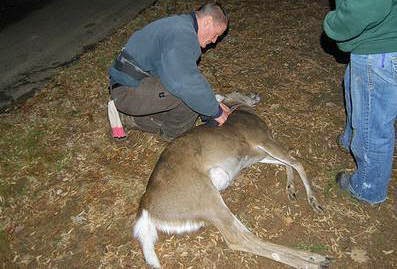Public support needed for humane deer management program
 |
| The Deer Spay program in action. [Photo by Tom Jackman] |
If you live around the City of Fairfax, you might be
surprised to see deer with “bling.” The deer wearing ear tags were part of a groundbreaking sterilization effort undertaken last winter called Deer Spay.
surprised to see deer with “bling.” The deer wearing ear tags were part of a groundbreaking sterilization effort undertaken last winter called Deer Spay.
That was the first time the Deer Spay approach was used in Virginia.
The results are being evaluated to determine whether sterilization is effective
in reducing the many problems caused by the overpopulation of deer, including
the destruction of vegetation, transport of ticks causing Lyme disease, and
collision with vehicles.
Proponents of Deer Spay see it as a humane, safe, and
ethical alternative to Fairfax County’s bowhunting program.
ethical alternative to Fairfax County’s bowhunting program.
The advocacy group known as Humane Deer Management facilitated
the Fairfax City pilot program along with Wildlife Rescue of Maryland. Wildlife
ecologist Anthony J. DeNicola removed the ovaries from 18 female deer,
rendering them incapable of breeding. The operations were done in a mobile
surgical unit, and the deer were released into their home location after a brief
rest.
the Fairfax City pilot program along with Wildlife Rescue of Maryland. Wildlife
ecologist Anthony J. DeNicola removed the ovaries from 18 female deer,
rendering them incapable of breeding. The operations were done in a mobile
surgical unit, and the deer were released into their home location after a brief
rest.
Funding for the Deer Spay program comes entirely from private
sources, and donations are urgently needed for Phase 2, which is scheduled to start this fall.
sources, and donations are urgently needed for Phase 2, which is scheduled to start this fall.
Visit the Humane Deer Management website to learn more about the “Spay her…Don’t kill her” campaign,
the benefits of Deer Spay, and how to support this program. Donations
can be sent to Pets Ltd. (Deer Fund), P.O. Box 7175,
Fairfax Station, VA 22039.
the benefits of Deer Spay, and how to support this program. Donations
can be sent to Pets Ltd. (Deer Fund), P.O. Box 7175,
Fairfax Station, VA 22039.


Funny that I read this article today …. the same day a Doe and Twin Fawns were caught munching away in my backyard!!!! The deer around here are becoming more difficult to keep away from yards, streets, and parks. It is near impossible to scare a deer away from your property or from danger. More work is needed to control the deer population in FFX Co. (specifically Falls Church 22042).
Reducing the number of deer would benefit FFX Co. home and car owners greatly. Having spayed deer running around WILL NOT (1) eliminate rut; (2) eliminate damage to understory trees and bushes; (3) eliminate damage to plant material in yards throughout the County; (4) eliminate deer/vehicle collisions. Other methods should be employed, such as (1) relocation; (2) managed hunts; (3) creating safety corridors.
The spaying effort is just another tool in the toolbox, but I don't see it as the only method that should be employed.
Just sayin' ….
A number of people in my neighborhood have Lyme Disease. We frequently have herds of 10 or more wandering through the yard, and we are inside the Beltway. Sure, spaying is a great idea, but we need short term solutions as well. We killed off their predators, now we need to step in and be the predator.
Removing the woods and forests by building housing developments have taken away the protective areas for wildlife to live – thus they are being forced to now live closer to us. Adapting to this new order of coexistence will now be necessary. With spaying, the number of deer are reduced – and along with normal mortality rates the population will be reduced. Interactions with deer can be reduced by slowing driving speeds, cutting back the vegetation alongside the roads so that drivers can see the deer. Lyme disease is not caused by deer – it is carried by rodents.